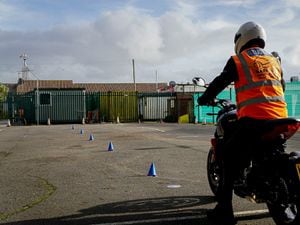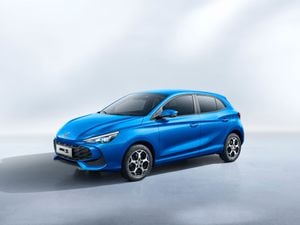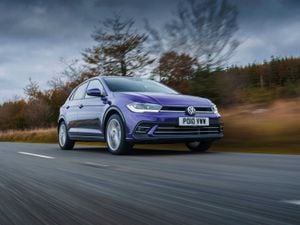What do I need to know about passing my motorcycle test: Module 1
MOD 1 is the first stage of your motorcycle test – we’re finding out just what it takes to pass.

Passing your motorcycle test is a gateway to a new life on two wheels. Between April and June of this year, just under 34,000 people took their practical motorcycle tests, with people up and down the country keen to get their certification to ride a motorbike on the road.
But whereas the testing routine for cars is relatively well known, how you get your motorcycle licence isn’t quite as clear. So here, with some help and advice from Triumph UK, we’re going to take a look through just what you need to do to get your bike licence.
What do I need to have in place before I do my practical test?
As tempting as it might be to rock up to the test centre and get started, you’ll need some things in order first. You’ll need to have done your Compulsory Basic Training (CBT) and gained a certificate for this. It’s a course you’ll need to take to start your full motorcycle licence training and it’s there to make sure that you can ride safely. It’s not a course that you can pass or fail, too, but it will need to be completed. Once you’ve done your CBT, you’ll be able to ride a 125cc with L-plates on the road, but it needs to be re-taken every two years.
You’ll also need to have passed your motorcycle theory test. This involves two parts; the first is a multiple-choice test while the second is a hazard perception video that requires you to ‘click’ a mouse when you see a hazard on the screen.
I’ve done my CBT and theory test – now what?

>
What happens next depends on age. If you’ve just turned 17, then you’ll be able to do your A1 licence which allows you to ride a 125cc motorcycle. However, many people hang on until the next stage as the A1 doesn’t bring huge benefits over a CBT, though it doesn’t need to be taken every two years.
If you’re over 19, then an A2 licence will be the best place to start. You’ll need to have your CBT and theory certificates, but if you pass you’ll be able to ride a bike that is restricted to 47bhp or a power-to-weight ratio of 0.26bhp per kilogram without L-plates. It’s a great entry into a much larger, more powerful bike than a 125cc.
However, if you’re over 24 or you’ve held your A2 licence for more than two years, you can do a Direct Access Course. Passing this allows you to ride a motorcycle of any power or engine size. It’s a lot like passing your full car test and it’s the one we’re doing here.
Is it a good idea to do training before my test?

>
Definitely. Even if you’ve had a few years of motorcycle experience – or even more – getting onto a ‘big’ bike is a completely different experience to riding a 125cc or smaller. The full motorcycle test also brings with it a unique set of requirements, so having some expert training can work wonders and make sure you’re properly prepared for your test.
Fortunately, there are training schools based up and down the country so you’re likely to be near one.
Is there a certain type of motorcycle I need for a Direct Access Course?
Yes. When you’re doing a Direct Access Course, you’ll need to be riding a motorcycle that is at least 595cc with at least 50kW of power. It also needs to weigh over 175kg. The Triumph Trident 660 that we’re practising on, with its 660cc engine and 59.6kW of power is just the right type of motorcycle for the job.
So where does my testing start?

>
If you’re going down the training route, then the first area you’ll start is with your Module 1 examination. It’s the first of two tests and is conducted entirely off-road in a dedicated site. It’s all about your handling and control of the motorcycle and, without it, you’re not able to proceed to your Module 2 exam.
You’ll need to bring your theory test pass certificate, a photocard driving licence (bring your passport if you have an older paper-style version) and your CBT certificate. You’ll also need appropriate safety clothing, including a helmet, proper boots without open toes, a heavy motorcycle jacket and trousers as well as proper gloves. Lightweight gear, such as trainers or tracksuits, is definitely not allowed and wearing such could result in your test being cancelled.
Mod 1 is broken up into seven parts, all tied up in a test that’ll usually take around 20 minutes from start to finish. To pass, you’ll need to have made no serious or dangerous faults – which are potentially dangerous or could involve actual danger to yourself, the examiner or anyone around – or no more than five riding faults, which are potentially dangerous but could become serious if repeated.
Wheeling the motorcycle
To show that you’re able to properly handle the motorcycle when you’re not riding it, you’ll be asked to ride into a box, put down the side stand, jump off and – while checking your surroundings frequently – wheel the motorcycle backwards in a slow and controlled manner, arcing into a second box and then returning the bike back to the stand. It’s all about control in this area. Examiners will be looking for plenty of safety checks for your surroundings.
Slalom and figure of 8
Up next, you’ll be asked to ride a slow slalom around a set of cones before entering into a figure of 8. It’s a good idea to focus on the cones much further ahead of you, rather than the one directly in front. This will keep your head up and your balance level; focus too much on the cone you’re approaching and it’s more of a likelihood that you’ll hit it.
The figure of eight, meanwhile, is another test of control. You’ll need to keep the revs reasonably high to maintain balance while trailing the rear brake will allow you to turn a little more sharply. Again, focusing on the area you’re planning to go will help to make a sharp, effective figure of eight.
Slow ride

>
This is pretty self-explanatory. The examiner will stand ahead of you and ask you to perform a controlled, slow ride in a straight line before stopping with your front wheel in a pre-determined box. Again, this is about clutch and brake control.
U-turn
If you’ve ever researched the motorcycle test, you might have found that the U-turn seems to carry the most amount of pressure. It’s designed to mimic a U-turn between two kerbs. You’ll also need to perform an over-shoulder check (often referred to as a ‘lifesaver’) before making the turn. Here, a good tip is to look further up the opposite ‘kerbside’ before turning, focusing on the area you want to go. If you go over the opposite white line you’ll fail the test, but it’s surprising just how sharply you can make a motorcycle turn.
Cornering and controlled stop
Your examiner will now ask you to drive up and around a curved section of cones before returning to them and before bringing the bike to a controlled stop. There’s no speed limit on this – as there are on the next stages – but it’s a good idea to build up a bit of speed before stopping. You’ll need to come to a halt within an area marked out by blue cones.
Cornering and an emergency stop

>
This section sees you perform the same left or right curved section, but this time you’ll need to progress to a minimum of 31mph before riding through a speed trap that the examiner will have pointed out. Once you’re through the trap, the examiner will raise their hand to indicate it’s time to perform an emergency stop. You’ll need to stop as quickly – but as safely – as possible, applying the more powerful front brake first before blending in the rear brake. It’s all about progressive pressure here, rather than a ‘snatch’ which can cause a lock-up or worse.
There’s no need to change down the gears, just come to an effective stop and bring the clutch in just before coming to a halt and select first gear.
Cornering and hazard avoidance

>
Finally, there’s the cornering and hazard avoidance section. Again, you’ll go around the left or right turn to build up speed and accelerate up to at least 31mph before passing through the speed-detecting equipment. Then, you’ll need to steer around a set of stationary cones before returning to a straight line and coming to a stop. If you clip a cone while performing this movement, you’ll fail straight away.
Is there anything else to think about?
Yes. Examiners will be looking at you closely to ensure that you’re doing the proper safety checks. So before moving off, you should be checking both shoulders. This needs to be done each time.
What next?
Your examiner will tell you when you’ve finished your test whether or not you’ve passed or failed. You’ll also be emailed a breakdown of any faults you may have incurred. If you’ve passed, you can continue on to take your Module 2 examinations. If you’ve failed, you’ll have to wait three working days before you can take it again.





